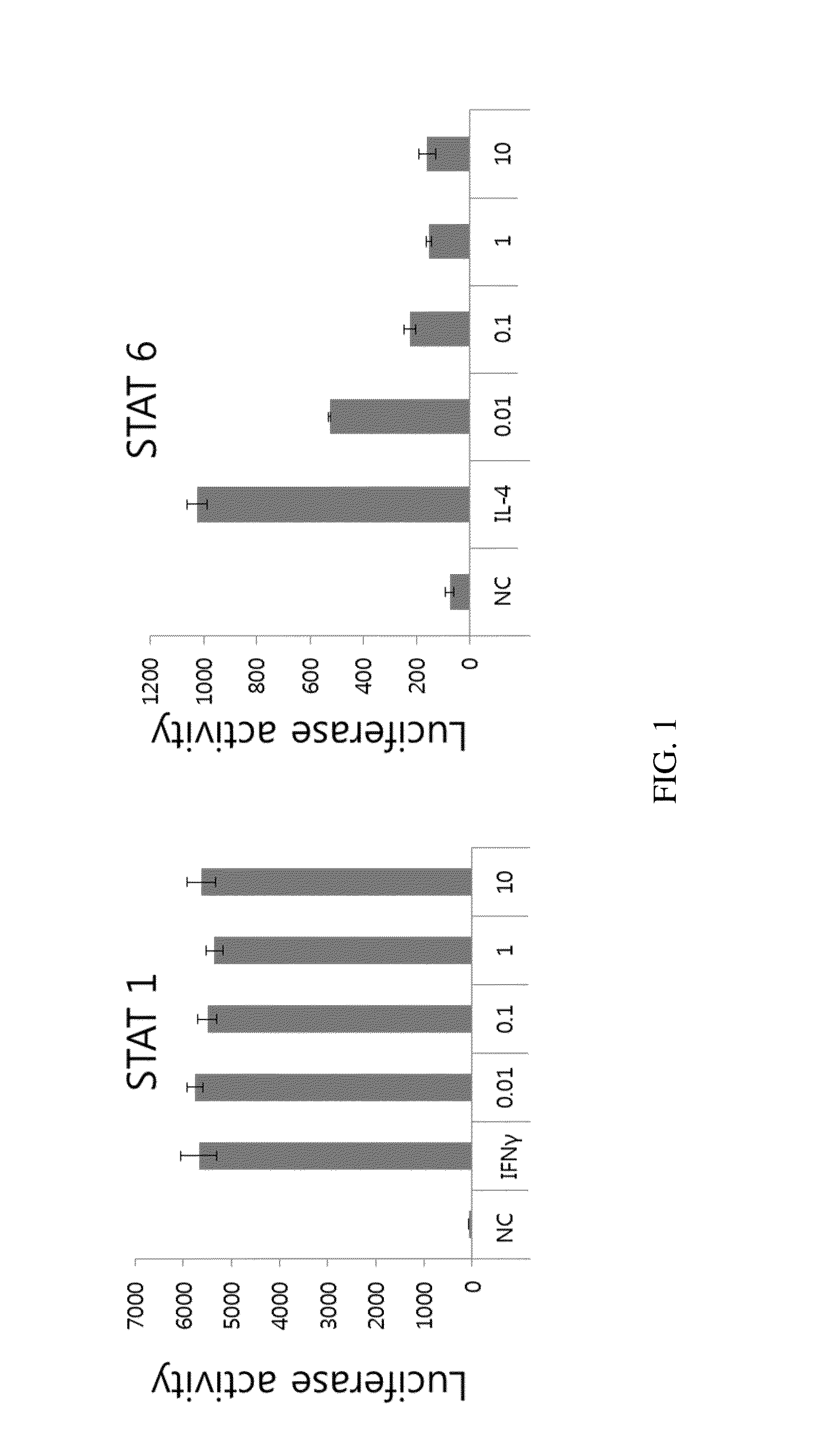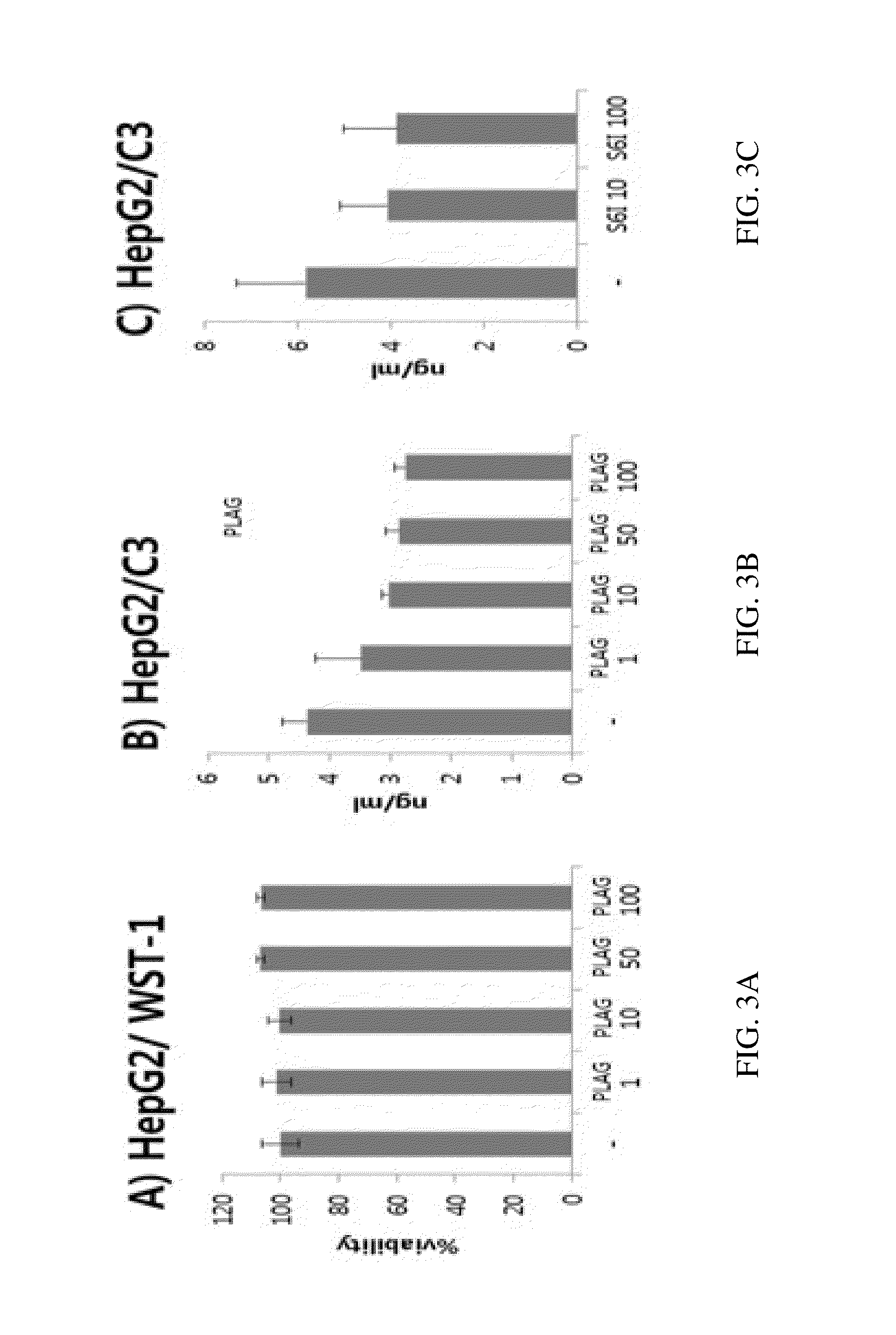Methods for treating leukopenia and thrombocytopenia
a technology of thrombocytopenia and leukopenia, which is applied in the direction of immunological disorders, extracellular fluid disorders, peptide/protein ingredients, etc., can solve the problems of reducing neutrophil migration, reducing neutrophil production, and 500 cells/l being considered severe, etc., to reduce neutrophil migration, stimulate neutrophil production, and enhance platelet production
- Summary
- Abstract
- Description
- Claims
- Application Information
AI Technical Summary
Benefits of technology
Problems solved by technology
Method used
Image
Examples
example 1
In Vitro Inhibition of PKCθ / p38 / ERK Activity in RBL-2H3 Cells
[0264]In vitro pharmacology studies in cell lines show that PLAG is capable of inhibiting the PKCO / p38 MAPK / ERK pathway, which is involved in the maturation of lymphoid progenitor cells from HSC. Dephosphorylation of p38 MAPK and ERK1 / 2 in PLAG-treated RBL-2H3 cells is determined by western blot analysis using anti-phospho-p38 and anti-phospho-ERK1 / 2 respectively. To activate the p38 and ERK1 / 2 in RBL-2H3 cells, the cells are sensitized with 50 ng / mL of anti-DNP-IgE overnight. After washing with PBS three times, 20 ng / ml of DNP-HSA is added. Each cell lysate for western blot is prepared in the PLAG-treated RBL-2H3 cells in a dose-dependent manner and incubated for the same time (15 min). β-actin is used as internal controls. ERK1 / 2 and p38 phosphorylation start immediately after IgE-antigen complex stimulation and remain sufficiently activated for 5 min. However, when IgE-antigen complex stimulation is exerted in PLAG pre-...
example 2
In Vitro Inhibition of Complement Activation Pathway
[0265]PLAG's activity for regulating complement activity is achieved by suppressing production of C3. The production of C3 depends on the activity of STAT6. Thus, it is hypothesized that PLAG suppresses the activity of STAT6, and thereby suppresses the production of C3, which is up-regulated or activated by chemotherapy.
[0266]Dephosphorylation of STAT6 in PLAG Treated Cells:
[0267]Dephosphorylation of STAT6 is examined using anti-phosphorylated STAT6 in U937, A549, and Jurkat cell lysates treated with PLAG concentration from 0.01 to 10 μg / ml. Phosphorylation of STAT6 is induced by treatment with 10 ng / ml of IL-4. Dephosphorylation of STAT1 is examined in the U937 cell lysate treated with PLAG (0.01 to 10 μg / ml). Phosphorylation of STAT1 is induced by 10 ng of IFN-γ treatment. Dephosphorylation of STAT1 and STAT6 is examined at 15 min after stimulation with IFN-γ and IL-4 respectively, in the PLAG pretreated cells. Western blot analy...
example 3
In Vivo Effect of PLAG on Neutropenia, Thrombocytopenia and Complement Activation In Vivo in Mice
[0279]Colony Forming Units in Spleen (CFUs) Assay In Vivo:
[0280]In order to determine the in vivo effect of PLAG on the recovery of hematopoiesis, a CFUs assay is performed in heavily irradiated mice. A microscopic examination of the spleens of mice treated with PLAG at a dose of 50 mg / kg / d i.p. or p.o. reveals a marked increase in the number of splenic nodules and the numbers of primitive progenitor cells and megakaryocytes in all treated animals.
[0281]In Vivo Efficacy Study in Mice:
[0282]The effect of PLAG for treatment of neutropenia and thrombocytopenia induced by chemotherapy (CIN) is evaluated in an animal model. Anti-cancer agents (Gemcitabine 50 mg / kg, Cyclosphosphamide 100 mg / , or Tamoxifen 50 mg / kg) are dosed daily for 3 weeks; PLAG is also administered 50 mg / kg daily for 3 weeks. After three weeks, neutrophils are harvested and counted with Auto Hematology Analyzer BC-5300. As...
PUM
| Property | Measurement | Unit |
|---|---|---|
| concentration | aaaaa | aaaaa |
| concentration | aaaaa | aaaaa |
| concentration | aaaaa | aaaaa |
Abstract
Description
Claims
Application Information
 Login to View More
Login to View More - R&D
- Intellectual Property
- Life Sciences
- Materials
- Tech Scout
- Unparalleled Data Quality
- Higher Quality Content
- 60% Fewer Hallucinations
Browse by: Latest US Patents, China's latest patents, Technical Efficacy Thesaurus, Application Domain, Technology Topic, Popular Technical Reports.
© 2025 PatSnap. All rights reserved.Legal|Privacy policy|Modern Slavery Act Transparency Statement|Sitemap|About US| Contact US: help@patsnap.com



